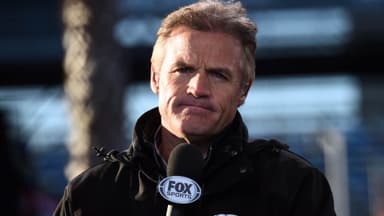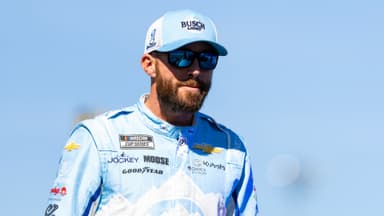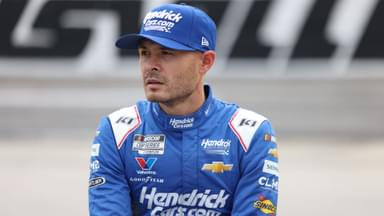For many years and in many cases, NASCAR pit crews were like being part of the U.S. Marines. The crew chief would be like a drill sergeant, shouting orders and sometimes even intimidating or criticizing personnel for mistakes. Trackhouse Racing is changing that hard-nosed militaristic attitude with a softer and more compassionate approach.
Advertisement
Team owner Justin Marks’ five-year-old organization hopes that less anxiety and a more humanistic approach with “Chief Kindness Officer” Shaun Peet, aka the team’s “Kindness Coach”, will improve pit crews’ mental, emotional and physical well-being both on- and off-track.
“I tell people, I run the department of unrealistic expectations,” Peet told Frontstretch. “Obviously, our job is to put four tires and two cans of fuel in the car in eight seconds.
“As a motorsports enthusiast, racing is a hard business, and a lot of times we can’t even be kind to ourselves. So we just have a different ethos at Trackhouse. Justin (Marks) wants to make sure that the employee experience and how people are valued at Trackhouse is different than any other race team experience.”
Team owner Justin Marks relies upon Peet’s advice
To illustrate Peet’s value to the team, one day before Marks purchased the entire operation from Chip Ganassi in 2020, he visited Peet’s home to get his advice and thoughts about the purchase and how to build out the program with a kinder but still very effective process.
“One of the biggest misconceptions our fans have is that when a driver comes on pit road, that the time of the pit stop dictates everything about how they come off pit road,” Peet said. “Nothing could be further from the truth.
Did you guess the team that has a kindness coach?@teamtrackhouse‘s Shaun Peet shares how he helps to promote a positive mindset both on and off the track. #NASCARhttps://t.co/Ra2eO1ZtIh pic.twitter.com/CFqZ3ow8zR
— Frontstretch (@Frontstretch) August 13, 2025
“There are a bunch of elements that make up, when a driver pits for tires and comes out for a second, third or fourth. How does that driver get on pit road? Where do they stop? In the box, right? These boxes are marked, and if the driver puts it on the mark, we can attack the car. If the driver doesn’t put it on the mark, we have to react to the car, and that takes time.
“Third thing is the adjustments the crew chief gives us. If we come down pit road and we’re putting two left rounds in the left rear, there’s no way we’re beating Chase Elliott off if he’s straight up. And then it’s how the driver reacts to the drop of the jack. How fast the pit stop is and how good the driver is leaving the box and his exit speed.
“So you have five or six things that go into that, but oftentimes, a driver will lose three stops on pit road, and everyone’s like, ‘Oh, the pit crew is terrible.’ That is one of the narratives that I would love to see changed. It never will change, and we’re fine with that, but that’s one of the misconceptions that follows the sport.”
How Peet went from minor league hockey enforcer and brawler to a “kindness coach”
Peet’s story gets even more unusual, as he’s a former minor league hockey player, self-professed enforcer, and unofficially designated brawler, where kindness oftentimes is met with punches on-ice. Peet not only oversees Trackhouse’s four cars but also the organization’s MotoGP program. How he got from playing hockey to his current role is an interesting story.
“My NASCAR journey was completely by accident,” Peet continued. “(I) grew up in a garage on Vancouver Island, came to the United States on a hockey scholarship, and kind of played college hockey for four years, and made my way through the minors. [I] made it to the American Hockey League, and they sent me … to Greensboro, North Carolina. They put me right in the middle of NASCAR country.
“And opening night, I was involved in a huge brawl, and I ended up being suspended for 18 games. Sitting up my suspension, I met a guy in the stands from NASCAR, and he said, ‘Look, when your dad comes down, I’ll tour him around the race shop.’ And this is long before athletes were pitting the cars.
“So back at Bill Davis Racing, my dad comes down, he takes me on a tour, practice is not going well, so the crew chiefs (are) like, ‘Get the hockey player in here,’ and it just kind of went from there. So honestly, it was not a fork in the road that I foresaw coming. But I’m 50 years old and feel like I haven’t worked a day in my life, so it was a blessing.”





![[US, Mexico & Canada customers only] June 15, 2025; Trackhouse Racing driver Shane Van Gisbergen during the NASCAR Cup Series Mexico City Race at Autodromo Hermanos Rodriguez](https://cdn-wp.thesportsrush.com/2025/12/765040ac-fsdgt-2025-12-01t104936.505.jpg?format=auto&w=384&q=75)


